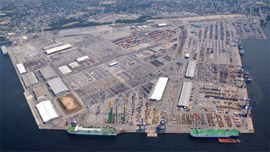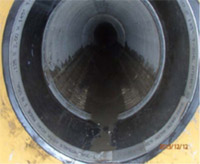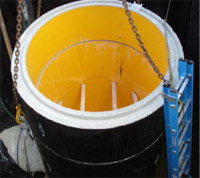Dundalk Marine Terminal

More than 14,000 direct jobs are generated by the Port of Baltimore (www.marylandports.com). The Dundalk Marine Terminal, one of six marine terminals, anchors the MPA roll-on/roll-off cargo business, including automobiles and machinery, and also handles forest products and containers.
Chromium processing at the former Baltimore Works plant in the Inner Harbor produced chromium ore processing residue (COPR). COPR from the Baltimore site was used as a fill material in certain areas around the harbor, primarily at the Dundalk Marine Terminal. At the time, similar fill operations were a common and legal practice in Maryland and throughout the area.
Because COPR contains hexavalent chromium, a hazardous material, it must be addressed under current environmental and safety laws. Investigations since 1970 indicate that chrome residue was used at approximately 148 acres of the 580-acre Terminal. The COPR was used to expand the terminal so that it could become the vital economic engine for Baltimore City and the State of Maryland that it is today.
In July 2012, the Maryland Department of the Environment (MDE) announced its selection of the final remedy to address COPR and hexavalent chromium at the Dundalk Marine Terminal. MDE selected Enhanced Isolation and Containment, with additional groundwater monitoring.
MDE based its selection on the information presented in the Corrective Measures Alternatives Analysis, or CMAA, submitted by the Maryland Port Administration (MPA) and Honeywell on January 11, 2011. The CMAA evaluated a wide range of remedial alternatives and then MDE evaluated the alternatives against eight criteria established in a 2006 Consent Decree that was filed in federal court. The criteria include protecting health, the environment, and the community over the short and long term, and considering the degree to which a remedy will interfere with ongoing Port operations. The CMAA is posted on the Maryland Department of the Environment's (MDE) website.
Investigations at the Terminal show that the only significant movement of hexavalent chromium is from groundwater flow into storm drains. The remedy selected by MDE focuses on preventing contaminated groundwater from entering the storm drains.
Storm Drain Relining and Repair
Stormwater at the Terminal is managed via a network of inlets and underground storm drains that collect and convey stormwater through outfalls to the Patapsco River. In the years since their construction, the storm drains became damaged, allowing groundwater containing hexavalent chromium to enter them. Storm drains located at 12th, 12.5th, 13th, 13.5th, 14th, and 15th Streets, are partially constructed within COPR fill, and were determined to present the main pathway for potential migration of chromium to the river. Hexavalent chromium has not been detected at significant levels in the river due to its rapid conversion to its non-hazardous form, trivalent chromium.
The relining and repair of storm drains were the major focus of the remedy. Other significant components involve installing tidal exclusion vaults, or storm drain vaults, at the remaining storm drains constructed in COPR; inspecting and repaving surface cover using new and improved methods; and developing a Performance Management Program (PMP) to monitor the corrective measures.
Work Underway
The lining of all six priority storm drains has been completed. A total of more than three miles of storm drains have been lined or replaced and the lining of all six priority storm drains has been completed. Rehabilitation of the largest one, the 15th Street storm drain, was completed in early 2019. Sampling of the 12.5th, 13.5th and 13th Street storm drains have all met monitoring requirements and have demonstrated the effectiveness of the rehabilitation and lining remedy.

The 15th Street storm drain relining was completed in early 2019
Several vaults and manholes have been installed and are being used to monitor storm water and facilitate inspections and repairs.

Installation of manhole at 15th Street storm drain
More information about the final remedy and its implementation
MPA and Honeywell's Fact Sheet

Approximately $3.0 billion in wages and $1.7 billion in business revenue is generated by the Port of Baltimore (www.marylandports.com)
AREA 1501/1602 ENHANCED CONTAINMENT
Area 1501/1602 is a 17-acre area that was filled with Chromium Ore Processing Residue (COPR). The area was constructed with a perimeter clay dike, underlying clay liner and covered or capped with asphalt pavement and additional material on top. Currently the area is used by the Maryland Port Administration to store cargo.
Work required on Area 1501/1602, as a part of MDE’s final remedy Enhanced Isolation and Containment, includes reducing water infiltration and mitigating lateral COPR movement to maintain the integrity of the cap. Details include:
Reducing Water Infiltration:
- installation of a geomembrane liner to reduce water infiltration
- placement of up to two feet of new cap and asphalt (containment cap) over 17 acres
- cover of an additional four acres to accommodate side slopes and service road
- construction in three phases over two years (2021-2022) to minimize disruption to Port operations
- no work to be performed outside the perimeter fence
Mitigate COPR Movement:
- install strain relief trench (SRT) along service road to address COPR movement
- rehabilitate portion of existing SRT along 15th Street storm drain
- connect Service Road SRT to 15th Street SRT
Construction Schedule:
- construction to be completed in three phases over two years (2021-2022) to minimize disruption to Port operations
- no work to be performed outside the perimeter fence
Health and Safety:
During 1501/1602 work the following procedures will be deployed to protect workers and the community:
- dust control measures
- use of water misting to suppress dust
- limiting size of the open area at any one time
- placing clean materials over impacted soil
- placing cover over open excavation daily
- additional Best Management Practices
- air monitors upwind and downwind from all intrusive work to measure for dust and chromium
- mitigation controls if dust levels rise
Important corrective measures protect health and the environment
MPA has a Health and Safety Plan (HASP) that includes a wide range of health and safety requirements to protect Port workers and contractors. Under the HASP, MPA has collected several hundred air samples for dust and hexavalent chromium in and around work zones. Sample results are well below levels set by the Occupational Safety and Health Administration. MPA also has implemented a Site Drinking Water Plan and performs routine sampling of its water distribution system. There have been no detections of hexavalent chromium in drinking water at the Terminal.
 COPR is contained beneath a surface cover of asphalt or concrete and clean fill within a well-defined 148-acre area at the Terminal. The cover prevents direct exposure to Terminal employees and keeps daily operations safe. Thirty-six acres have been resurfaced with new asphalt since 2005.
COPR is contained beneath a surface cover of asphalt or concrete and clean fill within a well-defined 148-acre area at the Terminal. The cover prevents direct exposure to Terminal employees and keeps daily operations safe. Thirty-six acres have been resurfaced with new asphalt since 2005.- Groundwater is affected only in the areas where there is COPR fill. Thirty-four on-site monitoring wells, monitored semi-annually, have shown that concentrations of hexavalent chromium at the perimeter of the Terminal are well below MDE standards for drinking water. Hexavalent chromium is not leaving the site boundary at unacceptable levels. Groundwater is not a source of drinking water at the Terminal or in the local community.
- Data from an extensive, ongoing, air-monitoring program, implemented by MPA and Honeywell since 2007, demonstrates that COPR is not being transported through the air. There are no detections of hexavalent chromium related to COPR in perimeter air monitors. A Human Health and Ecological Risk Assessment, which includes the sampling data, has been completed and submitted to the agency.
- Since 2006, more than three miles of storm drains have been relined to prevent hexavalent chromium from entering the drains. Tests have shown that relining significantly reduces groundwater infiltration.
- Hexavalent chromium has not been found in river sediments—nor has it been found in surface water above federal criteria—because it naturally changes into a nonhazardous form (trivalent chromium) when it reaches the water.
- Since 2006, the Groundwater Treatment Plant has treated an average of 42 million gallons of groundwater per year prior to discharge to the Patapsco River.
- MPA and Honeywell spend approximately $3.5 million annually to treat groundwater, and inspect, maintain, and repair the pavement at the Terminal.
